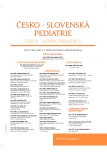Children dependent on technical support of breathing
Authors:
T. Doušová
Authors‘ workplace:
Pediatrická klinika 2. LF UK a FN Motol, Praha
Published in:
Čes-slov Pediat 2020; 75 (7): 421-425.
Category:
Overview
Use of noninvasive technical support of brething is increasing in children with chronic diseases of different etiology. These patients are recruited mainly from those, whose underlying condition affects the respiratory muscles. Impaired function of respiratory muscles leads to respiratory dysbalance and decreased effectiveness of the mucociliary clearance. Noninvasive ventilation and technically assisted cough can help to rebuild this respiratory balance. The type of noninvasive ventilation depends on the pathophysiological features of the respiratory failure, indications and technical aspects should be held by skilled multidisciplinary teams with technical competence. Setting up the cough assist device and evaluation of the mucociliary clearance has to be done by skilled respiratory therapist. The great heterogeneity of disorders, age ranges of affected children and their different prognoses present a challenge not only for the multidisciplinary team, but also for patient‘s family.
Keywords:
non-invasive ventilation – respiratory muscles – respiratory balance – technically assisted cough – multidisciplinary team
Sources
1. Amaddeo A, Frapin A, Fauroux B. Long-term non-invasive ventilation in children. Lancet Respir Med 2016; 4: 999–1008. https://doi.org/10.1016/S2213-2600(16)30151-5.
2. Perrin C, Unterborn JN, D’Ambrosio C, Hill NS. Pulmonary complica-tions of chronic neuromuscular diseases and their management. Muscle Nerve 2004; 29 (1): 5–27. https://doi.org/10.1002/mus.10487.
3. Laghi F, Tobin MJ. Disorders of the respiratory muscles. Am J Respir Crit Care Med 2003; 168: 10–48. https://doi.org/10.1164/rccm.2206020.
4. Fink JB. Forced expiratory technique, directed cough, and autogenic drainage. Respir Care 2007; 52: 1210–1221.
5. Warwick WJ. Mechanisms of mucous transport. Eur J Respir Dis 1983; 64: 162–167.
6. Abusamra R, Ross Russell R. Management of respiratory disease in child-ren with muscular weakness. Paediatr Child Health (United Kingdom) 2015. https://doi.org/10.1016/j.paed.2015.06.011.
7. Neumannová K, Doušová T, Sedlák V, et al. Doporučený postup České pneumologické a ftizeologické společnosti a České společnosti dětské pneumologie pro dlouhodobou domácí léčbu poruch expektorace pomocí přístroje CoughAs sist. Cesk Slov Neurol N 2017; 80/113 (4): 480–484. https://doi.org/10.14735/amcsnn2017480.
8. Schroth MK. Special considerations in the respiratory management of spinal muscular atrophy. Pediatrics 2009 May; 123 (Suppl 4): S245–S249. https://doi.org/10.1542/peds.2008-2952K.
9. Fauroux B, Pigeot J, Polkey MI, et al. Chronic stridor caused by laryngomalacia in children: Work of breathing and effects of noninvasive ventilatory assistance. Am J Respir Crit Care Med 2001; 164: 1874–1878. https://doi.org/10.1164/ajrccm.164.10.2012141.
10. Kaditis AG, Alvarez MLA, Boudewyns A, et al. Obstructive sleep disordered breathing in 2- to 18-year-old children: Diagnosis and management. Eur Respir J 2016; 47: 69–94. https://doi.org/10.1183/13993003.00385-2015.
11. Perriol MP, Jullian-Desayes I, Joyeux-Faure M, et al. Long-term adherence to ambulatory initiated continuous positive airway pressure in non-syndromic OSA children. Sleep Breath 2019; 23 (2): 575–578. https://doi.org/10.1007/s11325-018-01775-2.
12. Amaddeo A, Moreau J, Frapin A, et al. Long term continuous positive airway pressure (CPAP) and noninvasive ventilation (NIV) in children: Initiation criteria in real life. Pediatr Pulmonol 2016 Sep; 51 (9): 968–974. https://doi.org/10.1002/ppul.23416.
13. Panitch HB. Respiratory implications of pediatric neuromuscular disease. Respir Care 2017; 62: 826–848. https://doi.org/10.4187/respcare.05250.
14. Ramirez A, Delord V, Khirani S, et al. Interfaces for long-term noninvasive positive pressure ventilation in children. Intensive Care Med 2012; 38: 655–662. https://doi.org/10.1007/s00134-012-2516-1.
15. Gregoretti C, Pelosi P, Chidini G, et al. Non-invasive ventilation in pediatric intensive care. Minerva Pediatr 2010; 62: 437–458. https://doi.org/10.1097/pcc.0000000000000390.
16. Dohna-Schwake C, Stehling F, Tschiedel E, et al. Non-invasive ventilation on a pediatric intensive care unit: Feasibility, efficacy, and predictors of success. Pediatr Pulmonol 2011; 46: 1114–1120. https://doi.org/10.1002/ppul.21482.
17. Hull J. British Thoracic Society guideline for respiratory management of children with neuromuscular weakness: Commentary. Thorax 2012; 67: 654–655. https://doi.org/10.1136/thoraxjnl-2012-202043.
18. Simonds AK (ed). ERS Practical Handbook of Noninvasive Ventilation. European Respiratory Society; 2015. https://doi.org/10.1183/9781849840767.eph01.
Labels
Neonatology Paediatrics General practitioner for children and adolescentsArticle was published in
Czech-Slovak Pediatrics

2020 Issue 7
- What Effect Can Be Expected from Limosilactobacillus reuteri in Mucositis and Peri-Implantitis?
- The Importance of Limosilactobacillus reuteri in Administration to Diabetics with Gingivitis
Most read in this issue
- When should a physician consider ciliary dysfunction?
- How and when to perform pulmonary function testing in infants
- Long-term consequences of preterm birth on respiratory system in children
- Paediatric pulmonology in the Czech Republic and Slovakia
